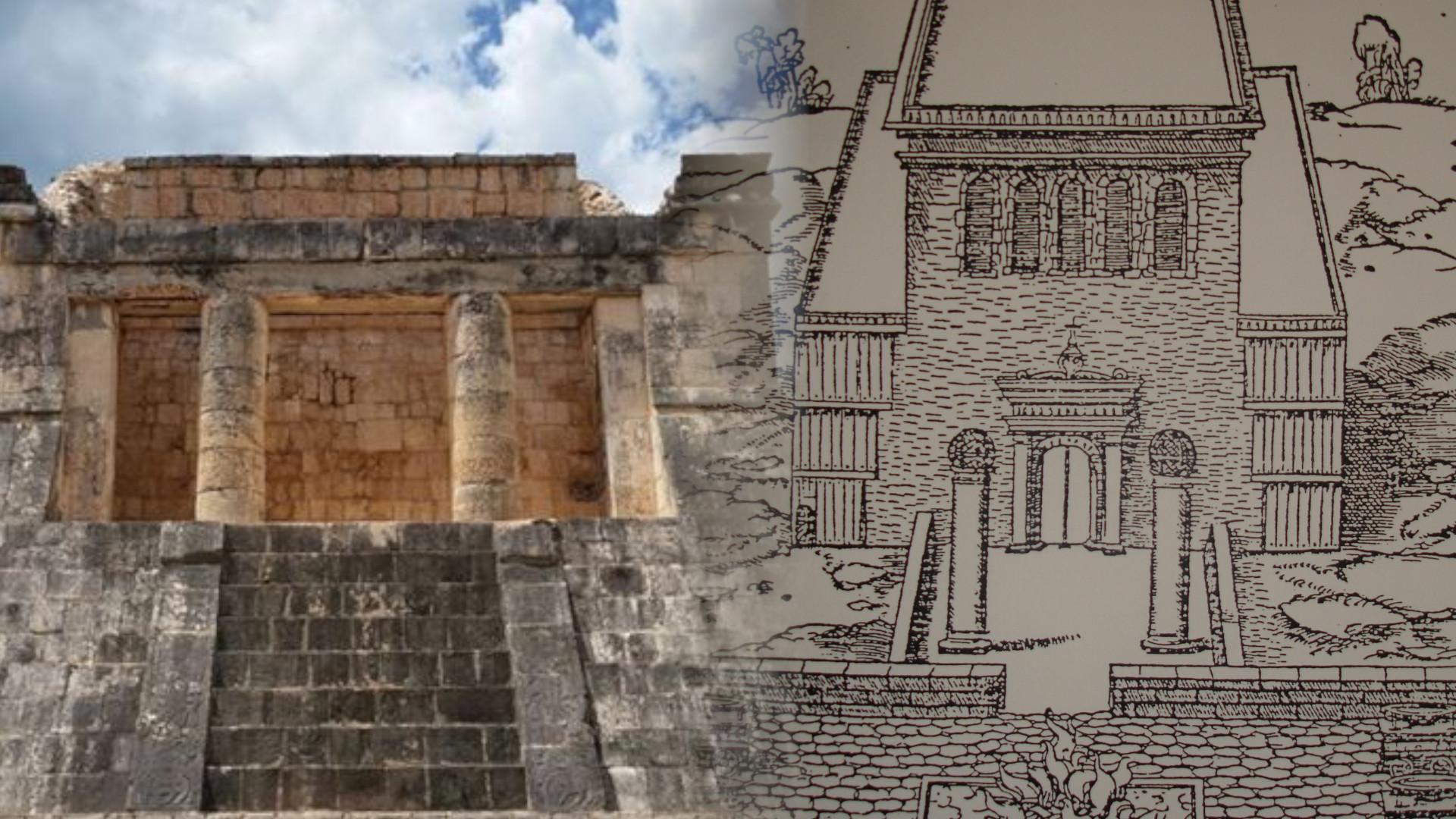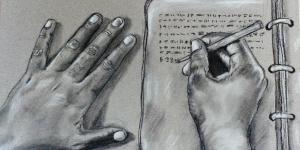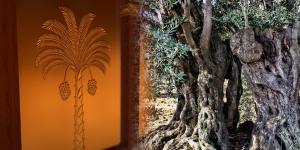You are here
How Are Some Ancient American Temples Similar to the Temple of Solomon?

2 Nephi 5:16
The Know
After Nephi and his family arrived in the New World, Nephi was forced to take “those who believed in the warnings and the revelations of God” into the wilderness to create what would later be known as the Nephite nation (2 Nephi 5:6). Nephi mentions that after settling a new part of the land, his people built a temple “after the manner of the temple of Solomon save it were not built of so many precious things. … But the manner of the construction was like unto the temple of Solomon; and the workmanship thereof was exceedingly fine” (2 Nephi 5:16).
When the Book of Mormon was first published, the idea of an Israelite temple outside of Jerusalem was a point of criticism leveled against the Book of Mormon and Joseph Smith. However, it is widely recognized by scholars today that while the central Israelite temple was undoubtedly that at Jerusalem, it was not uncommon for Israelites to build temples dedicated to the worship of Jehovah outside of Jerusalem. These temples were also typically patterned after the temple of Solomon. Famous examples include the Israelite temples found at Elephantine and Leontopolis in Egypt, although recent archeological finds have found even more temples within the land of Israel itself.1
Because Lehi’s branch of Israel built temples in the New World after their arrival, it is also interesting to look at temple building practices in pre-Columbian America. As many Latter-day Saint archeologists and scholars of the ancient Americas have observed, many similarities exist between the temple of Jerusalem and temples found in ancient America in terms of both structure and function.
For example, the temple of Solomon contained many unique features.2 As summarized by John Sorenson,
the temple of Solomon was built on a platform and on a hill. … Inside were distinct rooms of differing sacredness. Outside the building itself was a courtyard or plaza surrounded by a wall. Sacrifices were made in that space, atop altars of stepped or terraced form. … The temple building was oriented so that the rising of the sun on equinoctial day (either March 21 or September 21) sent the earliest rays—considered ‘the glory of the Lord’—to shine through the temple doors, which were opened for the occasion, directly into the holiest part.3
While there was some variation between temple designs in the New World, this same pattern was typical of many ancient Mesoamerican temples, many of which date to Book of Mormon times. For example, Mesoamerican temples were often built on tall platforms or hills. Occasionally, they would be built on top of pyramids to serve as an artificial hill, setting it apart from the city to “form exclusively religious centers that give the buildings intended for worship an importance that the metropolis limits to certain areas.”4 Some Mesoamerican temples also include two non-structural pillars at the entrance to the temple precinct, which was also a prominent feature of the entrance to Solomon’s temple (see 1 Kings 7:21).5
Furthermore, Mesoamerican temples contained a walled courtyard for sacrifices as well as inner rooms accessible only to the priest.6 These often included two rooms, with the innermost room understood to be the presence of a deity. These rooms “were typically covered with a curtain” and could be accessed only by “Maya rulers and priests.”7 This was not unlike the temple of Solomon, which followed the tabernacle’s pattern of dividing the Holy of Holies from the rest of the temple complex with a veil (see Exodus 36:35–36). Furthermore, the Holy of Holies contained the Ark of the Covenant, which served as God’s throne on the earth. For this and other reasons, some Mesoamerican scholars and even some early Spanish sources have likewise compared Mesoamerican temples to the temple of Solomon.8
In addition to the structural similarities between Old and New World temples, Mark Alan Wright has noted that these temples also shared functional parallels as well.9 At Mesoamerican temples, kings would be coronated, and on murals found at the temple in “San Bartolo, Guatemala (ca. 100 BC) we see an enthronement ceremony wherein the ruler sits upon a wooden tower or scaffold to receive the emblems of rulership.”10 A similar coronation at a temple is recorded in the book of Mosiah. At that coronation, King Benjamin addressed his people from a tower constructed for the event and declared his son Mosiah to be “a king and a ruler over” the people (Mosiah 2:30).
Mesoamerican temples also served as a place of ritual instruction, and some murals at the San Bartolo temple may be understood as depicting “a premortal existence; the ordering of the cosmos; a paradise of creation and the emergence of mankind; instruction on proper sacrifice; and the heavenly enthronement of the god of resurrection, culminating in a scene where a human accedes to a throne identical to the one used by the god of resurrection” as priests were initiated into the temple ordinances.11 Ultimately, Mayan rituals focused on entering the presence of the gods in the innermost sanctum of the temple, akin to entering the Holy of Holies.12 Similar themes and rituals have long been noted to have been connected to the temple of Solomon in the Old World.
In areas of the Americas, some of these temple-themed rituals are still performed today. V. Garth Norman, for example, has observed that many rituals performed at Izapa, Mexico, reflect ancient understandings of the temple in both the Old and New Worlds.13 Van C. Evans has also noted that some temples found in South America share similar functions and rituals to those in the Old World.14
The Why
Many early critics of the Book of Mormon initially believed that Nephi’s temple would have been anachronous to Israelite belief and forbidden by the law of Moses. However, as greater archeological evidence comes forth from both the Old and New Worlds, the opposite picture is actually painted. Indeed, it would appear that the temple was of utmost importance to Israelites in all parts of the world, as shown in the Book of Mormon.15 This is especially significant because these temples were found well after the publication of the Book of Mormon in 1830 and would have been unfamiliar to Joseph Smith.
As New World temples continue to be excavated, it should be remembered that these findings do not allow us to identify any specific ancient American temples as Nephite temples. However, these temples (especially those dating to Book of Mormon times) show that the type of temple Nephi claimed his people constructed would not have been out of place in parts of pre-Columbian America. In other words, while Nephi’s precedent and pattern for the temple was grounded in the Old World, it would have been consistent with patterns familiar to the New World people as well.
Ultimately, more significant than the architectural structure of these temples is the underlying significance of the buildings themselves. In both the Old and New Worlds, the temple was a place where God’s children could approach Him, make covenants with Him, learn about the Atonement of Jesus Christ, and become more like God. Because of the importance of temples, it is no surprise that the Lord has also restored the true order of temple worship in the latter days as well through His prophet Joseph Smith. As we stay true to our covenants made in the temple today, we can likewise hold fast to the Lord and become more like our Savior.
Further Reading
Evidence Central, “Book of Mormon Evidence: Mesoamerican Temples,” Evidence 257 (October 15, 2021).
Mark Alan Wright, “Axes Mundi: Ritual Complexes in Mesoamerica and the Book of Mormon,” Interpreter: A Journal of Latter-day Saint Faith and Scholarship 12 (2014): 79–96.
John L. Sorenson, Mormon’s Codex: An Ancient American Book (Salt Lake City, UT: Deseret Book; Provo, UT: Neal A. Maxwell Institute for Religious Scholarship, 2013), 326–328.
Brant A. Gardner, Second Witness: Analytical and Contextual Commentary on the Book of Mormon, 6 vols. (Salt Lake City, UT: Greg Kofford Books, 2007), 2:101–104.
John L. Sorenson, An Ancient American Setting for the Book of Mormon (Salt Lake City, UT: Deseret Book, 1985), 141–145.
- 1. For a discussion on Israelite temples outside of Jerusalem, see Book of Mormon Central, “Did Ancient Israelites Build Temples outside of Jerusalem? (2 Nephi 5:16),” KnoWhy 31 (February 11, 2016); William J. Hamblin and David Rolph Seely, Solomon’s Temple: Myth and History (London, UK: Thames and Hudson, 2007), 33; Stephen D. Ricks, “Temples beyond Jerusalem,” (paper presented at the 2022 Temple on Mount Zion Conference, Orem, UT, November 5, 2022). Josephus mentions the temple at Leontopolis (occasionally called the Temple of Onias by scholars) multiple times in his writings. This temple was destroyed by the Romans in AD 73, following the destruction of the Jerusalem temple by three years. Josephus claims at one point that this temple was built “after the pattern of that in Jerusalem, and of the same dimensions.” Josephus, Antiquities of the Jews, 13.1. This is not unlike the claim Nephi will make regarding his own temple.
- 2. For a greater discussion on structural similarities to Solomon’s temple among Mesoamerican temples, see Evidence Central, “Book of Mormon Evidence: Mesoamerican Temples,” Evidence 257 (October 15, 2021).
- 3. John L. Sorenson, An Ancient American Setting for the Book of Mormon (Salt Lake City, UT: Deseret Book, 1985), 143.
- 4. Laurette Sejourne, “El Templo Prehispanico,” Cuardernos Americanos 149 (1966): 130: “Esta elevación es debida a que esos santuarios no hacen parte de una ciudad y forman centros exclusivamente religiosos que confieren a los edificios destinados al culto una importancia que la metropoli limita a ciertas zonas.” Sejourne also notes that the error of conflating Mesoamerican temples with the pyramids upon which they were built originated with the Spanish conquistadores and remains the traditional, albeit erroneous, understanding of many people today (p. 129). Occasionally some may take issue with stairs being built in relation to Mesoamerican temples, allowing the petitioners to ascend the pyramid. This issue is often based off of Exodus 20:26: “Neither shalt thou go up by steps unto mine altar, that thy nakedness be not discovered thereon.” Furthermore, this is typically made in relation to Mesoamerican temples that do not date to Book of Mormon times and are built on top of a pyramid. Beyond the issue of dating these temples, this argument is faulty for at least two other reasons. First, as just noted, Mesoamerican temples were not built in the shape of pyramids. Rather, they were built on top of pyramids, which were an artificial mountain, similar to how the Jerusalem temple was built on a raised platform on a mountain. Second, the text of Exodus 20:26 is specifically referring to the altar of sacrifices, not the temple as a whole, and a closer textual analysis of this verse reveals that it is not actually prohibiting stairs being used to approach the altar. The word translated as steps in the King James Version is maʿǎlōt, which literally means “ascents.” This is the same word employed by Ezekiel when he sees the future temple of Jerusalem and its altar in Ezekiel 43:15–17, wherein he declares that its “stairs [maʿǎlōt, ‘ascents’] shall look toward the east.” This injunction in Exodus appears rather to be a warning for the priests not to climb upon the altar, based on the preposition ʿal, translated as unto in the King James Version but which could be rendered as upon. This reading is perhaps strengthened by the account of Elijah’s contest with the priests of Baal, as these priests desecrate the altar in multiple ways and are said to be “leaping upon [ʿal] the altar which was made” (1 Kings 19:26). See Spencer Kraus, “A Note on Temples, Stairs, and Mesoamerica,” Latter-day Light and Truth (blog), December 7, 2022.
- 5. John L. Sorenson, Mormon’s Codex: An Ancient American Book (Salt Lake City, UT: Deseret Book; Provo, UT: Neal A. Maxwell Institute for Religious Scholarship, 2013), 327.
- 6. For a discussion on sacrifices at Mesoamerican temples, see Mark Alan Wright, “Axes Mundi: Ritual Complexes in Mesoamerica and the Book of Mormon,” Interpreter: A Journal of Latter-day Saint Faith and Scholarship 12 (2014): 88–91.
- 7. Wright, “Axes Mundi,” 93.
- 8. Juan de Torquemada, Monarquia Indiana, 3 vols. (Mexico City, MX: Editorial Salvador Chavez, 1943), 2:160, observes: “It is worth noting the division of this [Aztec] temple; because we find that it has an interior room, like that of Solomon, in Jerusalem, in which the room was not entered by anyone but the priests.” This was also cited favorably in Sejourne, “El Templo Prehispanico,” 143, with Sejourne repeating much of the same ideas. Diego Duran, The History of the Indies of New Spain, trans. Doris Heyden (Norman, OK: University of Oklahoma Press, 1994), 130, also compared Montezuma I’s building of a temple to Solomon’s temple.
- 9. Wright, “Axes Mundi,” 81–82. Brant Gardner has also proposed that as the Nephites became more engrossed in New World cultures, it is possible there would have been a “Mesoamericanization” of their temples, which could allow other Mesoamerican temple patterns to eventually be accepted among Nephite audiences, “no doubt because of the shared symbolism between the [Old and New World] forms.” Thus, even if the Nephites would later build their temples using other architectural patterns, the symbolism and ordinances would have remained consistent. Brant A. Gardner, Second Witness: Analytical and Contextual Commentary on the Book of Mormon, 6 vols. (Salt Lake City, UT: Greg Kofford Books, 2007), 2:103.
- 10. Wright, “Axes Mundi,” 85.
- 11. Wright, “Axes Mundi,” 88. Regarding the inner rooms of the temples, Laurette Sejourne also notes that “archeology confirms the sanctuary in its role as a divine interior space” through which priests could receive “an initiation.” Sejourne, “El Templo Prehispanico,” 147: “Cualquiera que sea la realidad de esos esperpentos, la arqueología confirma el santuario en su papel de interioridad divina cuyo franqueo implica una iniciacion.”
- 12. See Wright, “Axes Mundi,” 91–93; see also the discussion regarding the curtain or veil of Mesoamerican temples above.
- 13. See V. Garth Norman, Izapa Sacred Space: Sculpture Calendar Codex, rev. ed. (Provo, UT: Brigham Young University Press, 2015), 205–209, for a discussion on the ordinances performed at Izapa today. See also V. Garth Norman, “Lessons from a Maya Temple Ceremony Dedicated to their Ancestors,” Meridian Magazine, June 11, 2020.
- 14. See Van C. Evans, “Wiraqocha and the Rites of the Temple in Raq’chi, Peru,” in The Temple: Past, Present, and Future. Proceedings of the Fifth Interpreter Foundation Matthew B. Brown Memorial Conference: The Temple on Mount Zion, 7 November 2020, ed. Stephen D. Ricks and Jeffrey M. Bradshaw (Orem, UT: Interpreter Foundation; Salt Lake City, UT: Eborn Books, 2021), 142–170; Van C. Evans, Willka Wasin Wiraqocha: The House of the Lord. Evidence of Jesus Christ's Visit to South America, and the Ordinances, Rituals, and Endowments of the Temples Built to Worship Him (self-pub., 2019).
- 15. Jared W. Ludlow, “A Tale of Three Communities: Jerusalem, Elephantine, and Lehi-Nephi,” Journal of Book of Mormon Studies 16, no. 2 (2007): 28–41, 95.
KnoWhy Citation
Related KnoWhys
Subscribe
Get the latest updates on Book of Mormon topics and research for free





